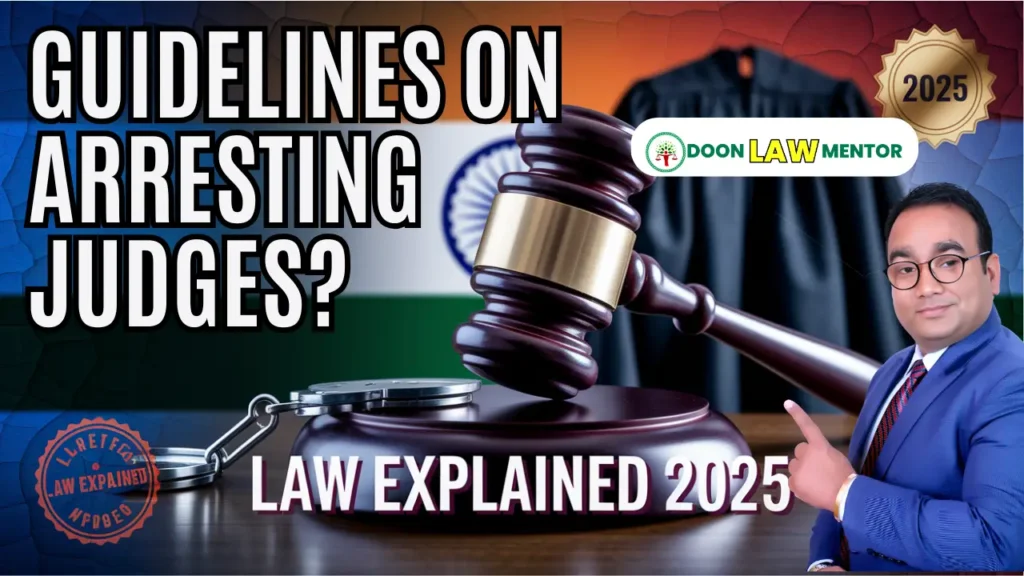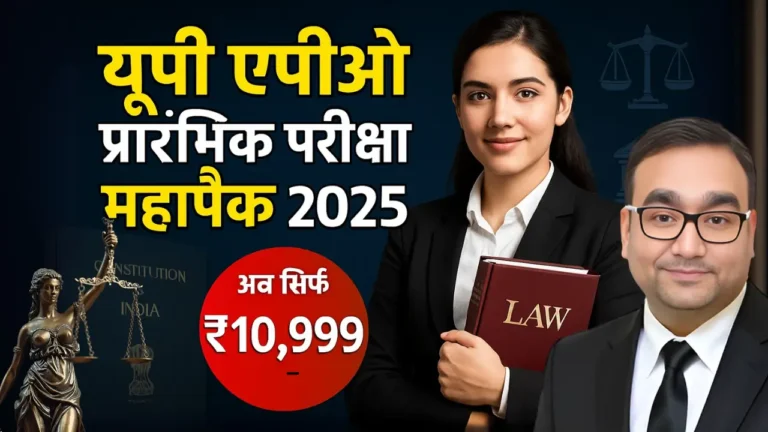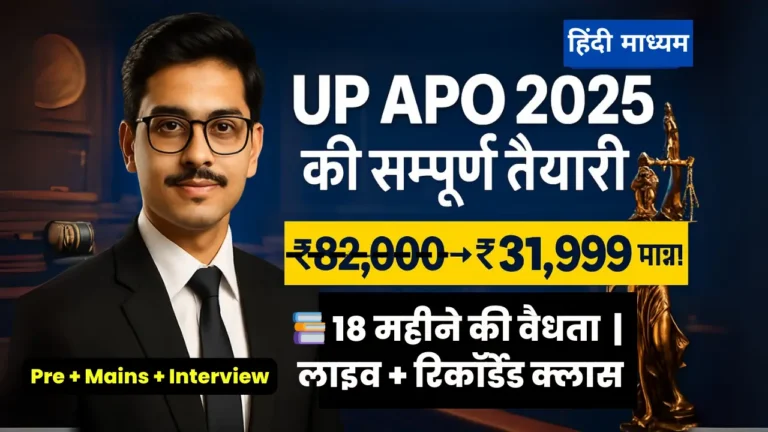Arrest of Judicial Officers in India is a sensitive legal matter. The Supreme Court has set strict guidelines to balance judicial independence and accountability. From CJI approval to in-house procedures, this blog explores the legal framework, landmark cases, and 2025 updates for legal aspirants.
Table of Contents
Introduction
Arrest of Judicial Officers in India is a topic that requires careful legal scrutiny. The judiciary plays a pivotal role in upholding justice and fairness in society. However, when a judicial officer, such as a judge or magistrate, is accused of a crime, the situation becomes complex. An arrest in such cases can impact public trust in the judicial system.
In 2025, this issue of arrest of Judicial Officers gained prominence due to the case of a suspended junior civil judge, S. Ramakrishna, in Andhra Pradesh. The Andhra Pradesh High Court emphasized the importance of following Supreme Court guidelines during such arrests. This case highlighted the delicate balance between judicial independence and accountability.
The Supreme Court has established specific guidelines to ensure that the arrest of judicial officers is handled with utmost care. These guidelines aim to protect judicial officers from harassment while ensuring they are not above the law. As of March 22, 2025, this topic remains highly relevant for legal aspirants and the public.
This blog provides a comprehensive analysis of the guidelines on the arrest of judicial officers. It covers landmark cases with full citations, legal provisions, and the in-house enquiry process. It also explores challenges, recent developments, and exam relevance for Judiciary aspirants. Let’s dive into this intricate legal framework.
1. Why Are Special Guidelines Needed for Arrest of Judicial Officers?
Judicial officers, including magistrates and judges, hold a unique position in India’s legal system. They are entrusted with delivering justice impartially and without fear. To perform this role effectively, they must be protected from harassment or retaliation. This principle of judicial independence is a cornerstone of the Constitution of India.
However, the principle of equality before the law under Article 14 applies to judicial officers as well. They can be held accountable for criminal acts, just like any citizen. The challenge lies in balancing this accountability with the need to safeguard their independence. An arbitrary arrest could undermine the judiciary’s credibility and public trust.
The Supreme Court addressed this issue in the landmark case Delhi Judicial Service Association v. State of Gujarat (1991) AIR 1991 SC 2176. In this case, a Chief Judicial Magistrate (CJM) in Nadiad was assaulted and arrested by police after criticizing their lack of cooperation. The court ruled that the arrest violated Article 136 of the Constitution, which grants the Supreme Court special powers to intervene.
To prevent such incidents, the Supreme Court laid down specific guidelines for the arrest of judicial officers. These guidelines ensure that arrests are not arbitrary while preserving the judiciary’s integrity. They have been reaffirmed by various courts, including a five-judge Constitution Bench in 2002, highlighting their importance.
2. What Are the Supreme Court Guidelines for Arrest of Judicial Officers?
The Supreme Court’s guidelines for the arrest of judicial officers are designed to protect their dignity and independence. These guidelines were established in Delhi Judicial Service Association v. State of Gujarat (1991) AIR 1991 SC 2176 and are binding under Article 141 of the Constitution. Here’s a detailed breakdown:
- Prior Intimation: If a judicial officer is to be arrested for an offence, the arresting authority must inform the District Judge or the High Court. This ensures oversight by a senior judicial authority before any action is taken.
- Technical or Formal Arrest: In cases where immediate arrest is necessary due to facts and circumstances, a technical or formal arrest can be made. However, this should only be done as a last resort to avoid unnecessary detention.
- Immediate Communication: The fact of such an arrest must be immediately communicated to the District and Sessions Judge of the concerned district. The Chief Justice of the High Court must also be informed to ensure transparency.
- No Police Station Without Approval: The arrested judicial officer cannot be taken to a police station without prior orders from the District and Sessions Judge. This prevents humiliation and ensures judicial oversight during the process.
- Communication Facilities: The arrested officer must be provided facilities to communicate with their family, legal advisors, and the District and Sessions Judge. This ensures they can seek support and legal advice promptly.
- No Statements or Tests Without Presence: No statement can be recorded, nor can a panchnama (record of evidence) be drawn, without the presence of the officer’s legal advisor or another judicial officer of equal or higher rank. Medical tests also require such presence to ensure fairness.
- No Handcuffing Unless Necessary: Handcuffing a judicial officer is prohibited unless they offer violent resistance or pose an imminent danger to life. If handcuffing occurs, the police must immediately report to the District and Sessions Judge and the Chief Justice of the High Court.
- Police Accountability: If the arrest or handcuffing is found to be unjustified, the police officers responsible will be guilty of misconduct. They may also be personally liable for compensation or damages, as determined by the High Court.
These guidelines are not exhaustive but provide minimum safeguards. They ensure that the arrest of judicial officers is conducted with respect for their position. The Supreme Court emphasized that these rules apply to all judicial officers, from magistrates to High Court judges.
3. The Legal Framework Governing Arrest of Judicial Officers
The arrest of judicial officers is governed by a combination of constitutional provisions, statutory laws, and judicial precedents. Understanding this framework is crucial for a thorough analysis of the issue.
- Constitutional Provisions: Article 14 of the Constitution guarantees equality before the law, meaning judicial officers are not above legal accountability. Article 21 protects their right to personal liberty, ensuring arrests are not arbitrary. Article 136 grants the Supreme Court special powers to intervene in cases involving judicial officers, as seen in Delhi Judicial Service Association v. State of Gujarat (1991) AIR 1991 SC 2176.
- Judges (Protection) Act, 1985: This Act provides immunity to judges for acts done in their official capacity. However, it does not protect them from personal crimes or mala fide actions. For example, a judge cannot claim immunity for bribery or assault unrelated to judicial duties.
- Bharatiya Nagrik Suraksha Sanhita 2023: Chapter V of the CrPC (Sections 41 to 60) / Chapter V of BNSS 2023 governs arrests in India. While these provisions apply to all citizens, the Supreme Court guidelines add an extra layer of protection for judicial officers. For instance, Section 46(4) prohibits the arrest of women after sunset, and similar care is extended to judicial officers.
- Judicial Precedents: The Delhi Judicial Service Association v. State of Gujarat (1991) AIR 1991 SC 2176 case is the cornerstone of arrest guidelines. Other cases, like D.K. Basu v. State of West Bengal (1997) AIR 1997 SC 610, provide general arrest guidelines, such as the right to be informed of the grounds of arrest, which also apply to judicial officers.
The interplay of these laws ensures that judicial officers are accountable while protected from misuse of power. For High Court and Supreme Court judges, the CJI’s role in approving FIRs, as established in K. Veeraswami v. Union of India (1991) 3 SCC 655, adds another layer of complexity to the arrest process.
4. The Role of the CJI in Arrests of Higher Judiciary
For High Court and Supreme Court judges, the process of arrest is more stringent. The Supreme Court in K. Veeraswami v. Union of India (1991) 3 SCC 655 ruled that no FIR can be filed against a sitting High Court or Supreme Court judge without the CJI’s approval. Since an arrest typically follows an FIR, this rule effectively applies to arrests as well.
The CJI acts as a gatekeeper to filter out baseless allegations. The CJI reviews the complaint and any supporting evidence to determine its credibility. If the allegations are deemed serious, the CJI advises the President of India to allow an FIR, which may lead to an arrest. This process ensures that higher judiciary members are not subjected to frivolous prosecutions.
If the allegations are against the CJI, the process is less clear. The K. Veeraswami v. Union of India (1991) 3 SCC 655 case suggested that the President of India must consult other Supreme Court judges. These judges then advise the President on the next steps, ensuring some level of oversight.
This CJI approval process has been debated over the years. In 2008, during the Provident Fund scam case, Justice B.N. Agrawal of the Supreme Court remarked, “Judges have not descended from heaven but come from the same society that produces corrupt politicians.” This statement, made in the context of Ghaziabad Provident Fund Scam Case (2008), highlighted the need for accountability, even for higher judiciary members. The CJI approval process adds complexity to the arrest of judicial officers at this level.
5. The In-House Enquiry Process Before Arrest
Before an arrest or FIR, allegations against judicial officers often go through an in-house enquiry. This confidential process allows the judiciary to handle complaints internally. It was first outlined in K. Veeraswami v. Union of India (1991) 3 SCC 655 and formally named in C. Ravichandran Iyer v. Justice A.M. Bhattacharjee (1995) 5 SCC 457.
The in-house enquiry begins when a complaint is received. The High Court Chief Justice reviews the complaint and seeks the officer’s response. If the matter is serious, it is escalated to the CJI. The CJI may form a committee of senior judges to investigate further.
The committee typically includes two Chief Justices of other High Courts and one High Court judge. They conduct a thorough investigation, following principles of natural justice. The committee submits a report to the CJI, who decides the next steps. The officer is given a copy of the report to respond.
If the allegations are substantiated, the CJI may ask the officer to resign or retire. If they refuse, they can be barred from judicial work, and the matter may escalate to an FIR or arrest with CJI approval. This process ensures that arrests are not the first step, protecting judicial officers from public humiliation while addressing allegations internally.
However, the in-house enquiry’s secretive nature has been criticized. In Indira Jaising v. Registrar General, Supreme Court of India (2015) Writ Petition (Civil) No. 13 of 2015, Senior Advocate Indira Jaising sought public disclosure of an enquiry report. The Supreme Court rejected the plea, stating that publicity would harm the judiciary’s reputation.
6. Landmark Cases Shaping Arrest Guidelines
Several landmark cases have shaped the guidelines for the arrest of judicial officers. These cases provide legal clarity and set precedents for handling such situations.
- Delhi Judicial Service Association v. State of Gujarat (1991) AIR 1991 SC 2176: This case involved the assault and arrest of a CJM in Nadiad by police. The Supreme Court condemned the arrest as a violation of Article 136. It laid down the guidelines for arrests, emphasizing the need to protect judicial officers from harassment.
- K. Veeraswami v. Union of India (1991) 3 SCC 655: This case established that no FIR can be filed against a High Court or Supreme Court judge without CJI approval. It also clarified that judges are public servants under the Prevention of Corruption Act, 1988, and can be prosecuted for corruption.
- State of U.P. v. Tulsi Ram (1970) AIR 1971 SC 221: In this case, a judicial magistrate issued a non-bailable warrant despite a High Court order. The court ruled that such negligence is not protected under the Judicial Officers Protection Act, 1850. The judge was held liable for damages.
- D.K. Basu v. State of West Bengal (1997) AIR 1997 SC 610: While not specific to judicial officers, this case laid down general arrest guidelines, such as the right to be informed of the grounds of arrest. These principles also apply to judicial officers, ensuring their rights are protected.
- C. Ravichandran Iyer v. Justice A.M. Bhattacharjee (1995) 5 SCC 457: This case named the in-house enquiry process as an alternative to immediate criminal action. It suggested this mechanism for handling allegations against judicial officers internally.
These cases highlight the judiciary’s commitment to balancing accountability and independence. They are essential for understanding the legal framework governing arrests.
7. Recent Developments in 2025
In 2025, the arrest of judicial officers came under scrutiny due to the case of S. Ramakrishna, a suspended junior civil judge in Andhra Pradesh. Ramakrishna was arrested in connection with a criminal case, but the police failed to follow Supreme Court guidelines.
The Andhra Pradesh High Court took suo moto cognizance of the matter. In December 2021, the court had already directed the police to adhere to the guidelines in Suo Moto v. State of Andhra Pradesh (2021) Writ Petition (PIL) No. 215 of 2021. In 2025, the court reiterated this stance, warning of serious consequences for non-compliance. The case highlighted the ongoing challenge of ensuring proper implementation of arrest guidelines.
Another notable development is the public discourse on judicial accountability. The 2025 Justice Yashwant Verma case, involving allegations of unaccounted money, raised questions about transparency in the judiciary. While this case focused on an FIR rather than an arrest, it underscored the need for clear procedures.
These developments show that the guidelines for the arrest of judicial officers are still relevant. They also highlight the need for better training for police and stricter enforcement by courts. The judiciary must address these issues to maintain public trust.
8. Challenges in Implementing Arrest Guidelines
Implementing the guidelines for the arrest of judicial officers faces several challenges. These challenges often lead to violations, as seen in the S. Ramakrishna case.
- Lack of Awareness: Many police officers are unaware of the Supreme Court guidelines established in Delhi Judicial Service Association v. State of Gujarat (1991) AIR 1991 SC 2176. This leads to procedural violations, such as failing to inform the District Judge or High Court before an arrest.
- Police Misconduct: The Delhi Judicial Service Association v. State of Gujarat (1991) AIR 1991 SC 2176 case showed how police can misuse their power against judicial officers. The CJM in that case was assaulted and humiliated, highlighting the need for stricter oversight.
- Delay in Justice: The requirement of CJI approval and in-house enquiries can delay action in genuine cases. This can frustrate victims and the public, leading to perceptions of judicial protectionism.
- Transparency Issues: The in-house enquiry process is confidential, raising concerns about accountability. Critics argue that this secrecy can protect guilty officers, as seen in Indira Jaising v. Registrar General, Supreme Court of India (2015) Writ Petition (Civil) No. 13 of 2015.
- Public Perception: High-profile cases like S. Ramakrishna’s can erode public trust in the judiciary. When guidelines are not followed, it creates a perception that judicial officers are above the law.
Addressing these challenges requires better training for law enforcement, stricter enforcement of guidelines, and reforms to enhance transparency. The judiciary must work to ensure that these guidelines are followed in letter and spirit.
9. Why This Matters for Legal Aspirants
The arrest of judicial officers is a critical topic for Judiciary, APO, and JLO exams. It falls under constitutional law and criminal procedure, both of which are heavily tested.
- Constitutional Law: Article 14 (equality before the law), Article 21 (right to personal liberty), and Article 136 (Supreme Court’s special powers) are directly relevant. Aspirants must understand how these provisions apply to judicial officers, especially in the context of Delhi Judicial Service Association v. State of Gujarat (1991) AIR 1991 SC 2176.
- Criminal Procedure Code (CrPC): Chapter V of the CrPC governs arrests, and the Supreme Court guidelines add a layer of protection for judicial officers. Questions on arrest procedures, as outlined in D.K. Basu v. State of West Bengal (1997) AIR 1997 SC 610, are common in exams.
- Landmark Cases: Cases like Delhi Judicial Service Association v. State of Gujarat (1991) AIR 1991 SC 2176 and K. Veeraswami v. Union of India (1991) 3 SCC 655 are frequently asked in objective and essay questions. Aspirants should know the facts, rulings, and guidelines from these cases.
- Current Affairs: The 2025 S. Ramakrishna case and the Justice Yashwant Verma case are relevant for exams. They provide real-world examples of judicial accountability and arrest procedures, making them potential exam questions.
Essay questions like “Should the arrest guidelines for judicial officers be more transparent?” are common. Understanding this topic can help aspirants excel in both written and interview stages of exams. It also prepares them for discussions on judicial accountability.
10. The Future of Arrest Guidelines
The guidelines for the arrest of judicial officers may evolve in the future. Public demand for transparency and accountability is increasing. This could lead to reforms in how such cases are handled.
- Enhanced Transparency: The judiciary might introduce limited transparency in the in-house enquiry process. For example, sharing enquiry outcomes without revealing sensitive details could rebuild public trust. This would address concerns raised in Indira Jaising v. Registrar General, Supreme Court of India (2015) Writ Petition (Civil) No. 13 of 2015.
- Digital Tools: Technology could improve accountability. A secure online portal for tracking complaints against judicial officers might be introduced. This would ensure transparency while protecting confidentiality, addressing modern challenges.
- Training for Police: Mandatory training programs for police on the Supreme Court guidelines could reduce violations. This would ensure better compliance and protect judicial officers from harassment, as emphasized in Delhi Judicial Service Association v. State of Gujarat (1991) AIR 1991 SC 2176.
- Clearer Procedures for CJI Allegations: The lack of a defined process for allegations against the CJI, as noted in K. Veeraswami v. Union of India (1991) 3 SCC 655, needs addressing. A structured mechanism would ensure fairness and accountability at the highest level.
The 2025 cases of S. Ramakrishna and Justice Yashwant Verma may push for such reforms. As India’s judiciary faces new challenges, these changes could strengthen public trust while preserving judicial independence. The future will likely see a more balanced approach to handling such cases.
Conclusion
The arrest of judicial officers in India is a complex issue that balances judicial independence with accountability. The Supreme Court guidelines, established in Delhi Judicial Service Association v. State of Gujarat (1991) AIR 1991 SC 2176, provide a framework to ensure arrests are handled with care. These guidelines protect judicial officers from harassment while ensuring they are not above the law.
Recent cases like S. Ramakrishna’s in 2025 highlight the challenges in implementing these guidelines. Issues like police misconduct, lack of transparency, and public perception continue to pose hurdles. The judiciary must address these challenges to maintain its credibility and public trust.
For legal aspirants, this topic is a goldmine for exams. It covers constitutional law, criminal procedure, landmark cases, and current affairs. Understanding the guidelines and their implications can help aspirants excel in Judiciary exams. As India moves forward, reforms are needed to ensure a fair and transparent process for the arrest of judicial officers.
Want to master Arrest of Judicial Officers for exams? Join Doon Law Mentor’s Courses for expert guidance. Follow @doonlawmentor on Instagram for updates!
FAQs
- Can a judicial officer be arrested in India?
Yes, but only with prior intimation to the District Judge or High Court. Supreme Court guidelines must be followed. - What are the guidelines for arrest of judicial officers?
The Supreme Court guidelines include prior intimation, no police station visits without approval, and no handcuffing unless necessary. - What did the Delhi Judicial Service case decide?
In Delhi Judicial Service Association v. State of Gujarat (1991) AIR 1991 SC 2176, the court ruled that arrests must follow specific guidelines to protect judicial officers. - Does the CJI need to approve arrests of High Court judges?
Yes, per K. Veeraswami v. Union of India (1991) 3 SCC 655, CJI approval is needed for an FIR, which precedes an arrest. - Can a retired judicial officer be arrested?
Yes, without CJI approval, as they lose special protections after retirement. - What happens if police violate arrest guidelines?
They can be held guilty of misconduct and may be liable for compensation, as per Delhi Judicial Service Association v. State of Gujarat (1991) AIR 1991 SC 2176. - Why is transparency a concern in this process?
The in-house enquiry is confidential, raising questions about accountability, as seen in Indira Jaising v. Registrar General, Supreme Court of India (2015) Writ Petition (Civil) No. 13 of 2015. - How does this topic relate to Judiciary exams?
It covers constitutional law, CrPC, and landmark cases, making it a key topic for exams. - What reforms are needed for arrest guidelines?
More transparency, digital tracking of complaints, and clearer procedures for CJI allegations are needed. - Why is the S. Ramakrishna case significant?
It highlighted the need for police to follow Supreme Court guidelines during the arrest of judicial officers.
#ArrestJudicialOfficers2025, #IndiaLaw, #JudiciaryExams, #JudicialAccountability #doonlawmentor #justiceyahvantverma #delhihighcourt #supremecourt #bestjudiciarycoaching







